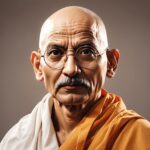Let’s start…
Gandhi Jayanti is an event celebrated in India to mark the birthday of Mahatma Gandhi on 2 October, and is one of the three National holidays in India. The United Nations celebrates the day as International Day of Non- Violence.

Father of the Nation, as he was called, led India’s freedom movement along with many other national leaders against the British rule in India.
Gandhi had studied law and he went to South Africa to represent a client. He joined the Indian National Congress and led nationwide compaigns for farmers, peasants and labourers. He also fought against caste discrimination and fought for expanding women’s rights.

Mahatma Gandhi was a great of India’s fight for freedom. He was a law graduate and was a biggest follower of Jainism. Between 1888 and 1891, he stayed in London and promised himself to be a vegetarian. Later, Gandhi joined the executive committee of the London Vegetarian Committee and then began reading a variety of holy books to gain knowledge on cross religious.
He led some of the most historic movements in India’s freedom struggle. He led Indians to break the salt law, through the Dandi March in 1930, which helped Indians believe that they can challenge the might of the British. He also led the Quit India movement in 1942.
Gandhi travelled various parts of India to motivate the country men and fight against British rule. In Ahmedabad, the capital city of Gujarat, in 1951, he established an ashram, which was common to all castes and religious. He spent a good amount of life at this ashram. In 1932, Gandhi boarded on a 6 day fast to safeguard the decision of British to seperate untouchables.
The Martyr’s Column is the place where Mahatma Gandhi was attacked on January 1948.
The Raj Ghat, the place where the body of Mahatma Gandhi was scalded on 31 January 1948.
Gandhi was killed by Hindu nationalist Nathu Ram Godse on January 30, 1948.
For more post visit our official website
